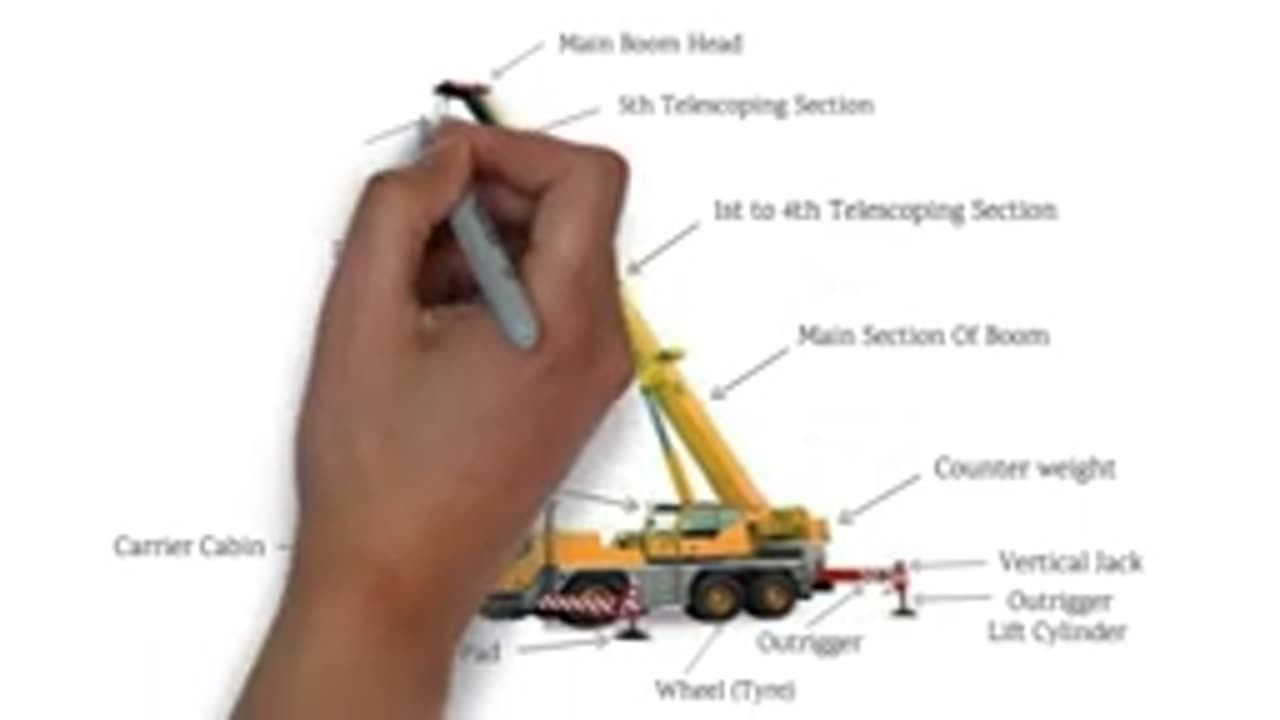Premium Only Content

Parts of Mobile Crane _ Mobile Crane _ HSE STUDY GUIDE
### **HSE Study Guide: Parts of a Mobile Crane**
This guide provides a detailed overview of the components of a mobile crane, focusing on their function and importance in safe operation. Understanding these parts is essential for inspection, maintenance, and safe use.
---
## **1. Major Parts of a Mobile Crane**
### **1.1. Boom**
- **Description:**
- The long, telescopic or fixed arm used to lift and move loads.
- **Types:**
- Telescopic Boom: Can extend and retract for adjustable reach.
- Lattice Boom: Made of interlocking sections for added strength.
- **HSE Note:**
- Inspect for cracks, deformation, or wear. Ensure the boom is properly lubricated and aligned.
---
### **1.2. Hook**
- **Description:**
- A device at the end of the lifting line used to attach loads.
- **Key Features:**
- Equipped with a safety latch to prevent the load from slipping off.
- **HSE Note:**
- Check for deformation, cracks, and proper functioning of the safety latch.
---
### **1.3. Wire Rope**
- **Description:**
- The cable used to lift and lower loads, running over pulleys and drums.
- **HSE Note:**
- Inspect for kinks, bird-caging, fraying, corrosion, or broken wires.
---
### **1.4. Hoist Drum**
- **Description:**
- A drum that holds the wire rope, allowing it to be spooled in and out.
- **HSE Note:**
- Ensure smooth operation and proper alignment of the wire rope on the drum.
---
### **1.5. Counterweight**
- **Description:**
- Heavy weights attached to the rear of the crane to balance the load and prevent tipping.
- **HSE Note:**
- Verify that the counterweight matches the load requirements and is securely attached.
---
### **1.6. Outriggers**
- **Description:**
- Extendable supports used to stabilize the crane during lifting operations.
- **HSE Note:**
- Ensure outriggers are fully deployed and positioned on firm, level ground or supported with pads/mats.
---
### **1.7. Rotex Gear**
- **Description:**
- A gear system that allows the boom and cab to rotate 360 degrees.
- **HSE Note:**
- Check for smooth rotation and proper lubrication.
---
### **1.8. Cab**
- **Description:**
- The operator’s compartment housing controls for crane operation.
- **Key Features:**
- Equipped with visibility aids, control panels, and safety features.
- **HSE Note:**
- Keep the cab clean and ensure all controls, indicators, and alarms are functioning correctly.
---
### **1.9. Hydraulic System**
- **Description:**
- Provides power to the boom, hoist, and outriggers using hydraulic cylinders and fluid.
- **HSE Note:**
- Inspect hoses, pumps, and fluid levels for leaks or damage.
---
### **1.10. Slewing Ring**
- **Description:**
- A rotating base that connects the superstructure to the undercarriage.
- **HSE Note:**
- Check for cracks, wear, and proper lubrication.
---
### **1.11. Load Moment Indicator (LMI)**
- **Description:**
- A safety device that monitors and displays the crane’s load, boom angle, and radius.
- **HSE Note:**
- Ensure the LMI is calibrated and functional to prevent overloading.
---
### **1.12. Undercarriage**
- **Description:**
- The lower part of the crane, which includes the chassis, wheels, or tracks for mobility.
- **HSE Note:**
- Inspect tires or tracks for wear and damage. Ensure brakes and steering are functioning.
---
## **2. Safety Attachments and Accessories**
### **2.1. Sheaves and Pulleys**
- **Function:**
- Used to guide the wire rope and reduce wear.
- **HSE Note:**
- Inspect for alignment, cracks, and smooth operation.
### **2.2. Jib (Optional Extension)**
- **Function:**
- An additional arm attached to the boom to extend its reach.
- **HSE Note:**
- Ensure the jib is properly secured and inspected for damage.
### **2.3. Anti-Two-Block Device**
- **Function:**
- Prevents the hook block from striking the boom tip, which can damage the crane.
- **HSE Note:**
- Test functionality before operations.
### **2.4. Ballast**
- **Function:**
- Additional weights used to increase stability during heavy lifts.
- **HSE Note:**
- Verify proper placement and secure attachment.
---
## **3. Inspection and Maintenance Guidelines**
- **Daily Inspection:**
- Check the boom, wire rope, hook, hydraulic systems, and tires before each use.
- **Periodic Maintenance:**
- Perform thorough inspections monthly or as per manufacturer recommendations.
- **Record Keeping:**
- Maintain logs for inspections, repairs, and replacements.
- **Training:**
- Ensure operators are trained and certified to identify issues with crane components.
---
## **4. Key HSE Considerations**
1. **Stability:**
- Always use outriggers and counterweights to maintain balance.
2. **Load Limits:**
- Never exceed the crane's rated capacity.
3. **Site Conditions:**
- Ensure the crane is operated on level, firm ground.
4. **Communication:**
- Use standard hand signals or communication devices between operators and signalers.
5. **Emergency Procedures:**
- Be prepared to respond to mechanical failures or load drops.
---
Would you like a checklist, diagram, or quiz to accompany this guide?
-
 44:39
44:39
Kimberly Guilfoyle
2 hours agoBetter Days Ahead for the FBI, Live with Asm Bill Essayli & John Koufos | Ep.199
19.7K12 -
 1:40:29
1:40:29
In The Litter Box w/ Jewels & Catturd
22 hours agoWhat Did You Do Last Week? | In the Litter Box w/ Jewels & Catturd – Ep. 748 – 2/24/2025
62.7K19 -
 23:34
23:34
Stephen Gardner
2 hours ago🔥CNN PANICS over $5000 DOGE Dividend | Trump Orders bigger Audits
24.2K65 -
 1:53:54
1:53:54
The White House
4 hours agoPresident Trump Holds a Press Conference with President Emmanuel Macron of France
49K30 -
 1:48:31
1:48:31
The Officer Tatum
4 hours agoLIVE MSNBC DROPS HAMMER On Joy Reid as STAFFERS PANIC! + More Ep 67
67.2K47 -
 59:36
59:36
Chad Prather
3 hours agoTRUMP TAPS DAN BONGINO TO HELP LEAD FBI - IT’S OVER FOR THE DEEP STATE!
54.7K27 -
 4:18:28
4:18:28
Barry Cunningham
9 hours agoTRUMP DAILY BRIEFING: DAN BONGINO TO FBI | LIVE PRESS CONFERENCE WITH MACRON | DOGE MELTDOWN!
50.8K13 -
 2:08:16
2:08:16
Mike Rowe
3 days agoTim Allen Loves The Ballet | The Way I Heard It with Mike Rowe
49.3K17 -
 1:42:25
1:42:25
Russell Brand
8 hours agoWar, Wokeism & Wealth: The Forces Reshaping Our World – SF542
138K87 -
 1:24:13
1:24:13
vivafrei
8 hours agoMadness in Ireland! The War on Women, Children and the Attempt to Silence Whistleblower Jana Lunden!
97.9K54